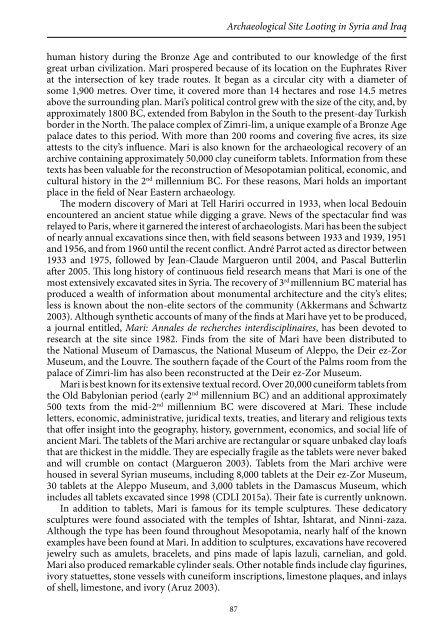Countering
Book_observatory_illicit_traffic_version%20issuu
Book_observatory_illicit_traffic_version%20issuu
Create successful ePaper yourself
Turn your PDF publications into a flip-book with our unique Google optimized e-Paper software.
Brian I. Daniels and Katharyn Hanson<br />
Analysis of satellite imagery by the AAAS (2014b) showed that the site of Mari had<br />
been extensively looted. Between August 2011 and March 2014, 165 looters’ pits could be<br />
identified. The spatial distribution of these pits was inconsistent, although the majority<br />
of the pits were dug on the north slope of the tell, especially to the east of the Palace of<br />
Zimri-Lim. Less concentrated clandestine excavations could be identified at the extreme<br />
northwestern and southern boundaries of the site. Imagery in March 2014 identified a<br />
vehicle at the site – possibly a medium-duty truck – and suggesting that looting might<br />
be ongoing at that time. With 165 pits formed over a period of 965 days, an average of<br />
0.17 pits were formed per day. The overall distribution and frequency of looters’ pits<br />
suggests that illicit activity was an ad hoc or irregular for this period. By November 2014,<br />
however, the number of looters’ and in the rate of excavation had increased dramatically,<br />
indicating a shift in the process and frequency of extraction. For the period between 25<br />
March 2014 and 11 November 2014, approximately 1,286 pits were excavated over 232<br />
days, an average rate of 5.5 pits per day over the seven months. This pillage occurred<br />
during the same period that ISIS consolidated its control over the surrounding area,<br />
although we do not know whether ISIS sanctioned these excavations, conducted them as<br />
part of its operations, or whether conditions allowed illicit excavations to occur.<br />
Case Study: Umma, Iraq<br />
As with most archaeological sites in southern Iraq, Umma (also known as Tall Guha,<br />
Tall Jukha, Tall Jukhah, Tell Jukha, Tell Jukhah, Tell Jokha, Chokha, Djokha or Djoha)<br />
rises up from the flat landscape as a tell composed of collapsed ancient adobe structures<br />
and the remains of millennia of human habitation. Archaeologists have long noted<br />
Umma’s large size (Adams and Nissen, 1972; Andrae, 1903; Ur, 2014); it has been<br />
generally assumed to cover about 2000 square kilometres (Adams, 2008). Umma has<br />
suffered from looting since the site was first recognized as a source for clay cuneiform<br />
tablets, a popular and collectable type of ancient Mesopotamian artifact. The history<br />
of the ancient city of Umma and its surrounding landscape is known primarily from<br />
this corpus of looted tablets. Umma began as a smaller prehistoric city that rose to<br />
prominence during the Early Dynastic Period (approximately 2950-2350 BC) and<br />
excavations and texts suggest that though it declined during the Akkadian through Ur<br />
III periods (approximately 2335-2000 BC), Umma regained its size again during the<br />
Old Babylonian period (2000-1600 BC) (Adams 2008; Ur 2014). The archives from the<br />
competing neighboring city of Girsu detail a long standing border dispute between the<br />
two powers, although recent excavations suggest that textual evidence from the looted<br />
tablet corpus may be misleading (Oraibi Almamori 2015). One of the great tragedies<br />
of the continuous looting at Umma is that without contextual evidence for the Umma<br />
tablets and other artifacts the role of this city in regional politics of the Early Dynastic<br />
period will be difficult to fully understand.<br />
Despite its importance, Umma was not archaeologically excavated until the 1990s,<br />
although looting at the site dates back to the 19 th century, if not earlier. It was clear<br />
that Umma was being looted precisely because significant numbers of unknown tablets<br />
from Umma were appearing for sale in Europe. Based on this information and following<br />
a visit by a journalist and SBAH officials, the Iraqi government funded an emergency<br />
salvage project at the site of Umma, and nearby Umm al-Aqarib between 1998 until<br />
2003. SBAH deterred looters by hiring locals, stationing over 18 guards, and working<br />
continuously (Gibson 2008). The SBAH excavations discovered an Early Dynastic<br />
Temple of Shara and remarkable architecture with well-preserved elements, including<br />
88


